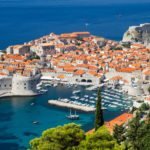Dubrovnik, Croatia: “The Pearl of the Adriatic”
About Dubrovnik:
 One of the most unique cities on the Adriatic, and known as the “Pearl of the Adriatic”, Dubrovnik has become one of the most popular destinations in Europe. It has a rich history and beautiful vistas as well. The city was built on maritime trade: in the Middle Ages it became the only city-state in the Adriatic to rival Venice. Dubrovnik became one of the centers of the development of the Croatian language and literature and was home to many notable poets, playwrights, painters, mathematicians, physicists and other scholars.
One of the most unique cities on the Adriatic, and known as the “Pearl of the Adriatic”, Dubrovnik has become one of the most popular destinations in Europe. It has a rich history and beautiful vistas as well. The city was built on maritime trade: in the Middle Ages it became the only city-state in the Adriatic to rival Venice. Dubrovnik became one of the centers of the development of the Croatian language and literature and was home to many notable poets, playwrights, painters, mathematicians, physicists and other scholars.
George Bernard Shaw once said that “those who seek paradise on Earth should come to Dubrovnik and find it“. The crystal-clear water and natural beauty of this walled city have made it a favorite of royalty, presidents and diplomats over the years. Pope John Paul II was a fan of Dubrovnik and was even made an honorary citizen. The city is famous for his visit here back in 2003.
Dubrovnik is one of our favorite destinations. It is an easy city for walking: stroll down the main street lined with shops or wander off the side streets to find an interesting cafe. You might also want to climb the walls overlooking the city for a breathtaking view. It is a bit of a climb, but there plenty of opportunities to pause along the way: just pretend that you are stopping to admire the view if you are out of shape but don’t want everyone to know it!
During the recent war ( 1990-2001) the city came under blockade and bombardment for 16 months…both from the sea and from the mountains on land. However, since the city is mostly stone and designed to withstand a siege, it remained mostly unscathed except for the red tile roofs which were extensively damaged. These have now all been replaced and there is little to show of the damage inflicted.
About Saint Blaise:
Blaise was a physician and later was made bishop of Sebastia, Armenia. Under emporer Licinius, he was seized and brought to prison. On the way he miraculously cured a boy from fatally choking. After being torn with wool combers’ irons, he was beheaded in 316.
Saint Blaise is the patron saint of Dubrovnik, and you will find several places of interest here that are related to him. The Feast Day of Saint Blaise (February 3) has been celebrated here since 897 and begins on Candlemas Day (February 2) with the release of white doves, the symbols of freedom and peace, in front of St Blaise Church.
At the same time Saint Blaise’s flag is raised on the Column in the center of the city. Then, on the actual Feast Day, a solemn high Mass is held at the Cathedral and then the relics of St Blaise are carried in procession from the Cathedral to the Church of Saint Blaise.
Catholic Places of Interest in Dubrovnik
Dubrovnik, although small in size, hosts several churches. The most famous are:
Saint Ignatius Church & Collegium Ragusinum: The church was completed in 1725 and patterned after the Chiesa del Gesu in Rome, the mother church of the Jesuit order. It is the largest of the churches in Dubrovnik and is next door to the Jesuit College, founded even earlier, in 1647.
The Cathedral of the Assumption: contains reliquaries of the head, and the arm of the patron saint of Dubrovnik: Saint Blaise.
The Church of Saint Blaise: Some relics of the saint are kept here and groups who arrange Masses there often receive the Blessing of the Throats with special candles available there. Many churches throughout the world have a blessing of the throats on February 3 as well.
There is also a gift shop in the church where you can purchase items including the special candles used in the Blessings of the Throats.
Along with his relics are the most prized relic of the Cathedral: what is reputed to be the loincloth of Jesus.
The Old Pharmacy in Franciscan Monastery in Dubrovnik is one among the oldest pharmacies in Europe. It was founded in 1317 as an in-house pharmacy for Franciscan friars which was later introduced to the public servicing the whole Town’s population and even beyond the town’s walls.
Nowadays, in the courtyard of Franciscan Monastery’s complex, intricate cloister leads to the Old Pharmacy Museum where among the exhibits you can see various pharmaceutical tools, containers, grinders and similar from the times of old Ragusa. They also offer items for sale…their skin cream made from herbs is especially popular.
Traveling to Dubrovnik:
There is an international airport in Dubrovnik, although most flights here are from Rome or Zagreb, the capital of Croatia.
If traveling from Italy, we recommend the overnight ferry from . There are ferries that run from Bari, Italy to Dubrovnik. You save time overall, since you would be sleeping somewhere anyway. Just be sure to book your cabin in advance. It is a nice way to relax on your journey….and there is a cafeteria on board.
Dubrovnik has become a popular port for cruise lines, and as a result it may be crowded on days when a ship docks here, but it is still a great city to visit at any time.
Click here for the official Dubrovnik Tourist Board website


How ca I find out the weekdays mass times in Dubrovnik please?